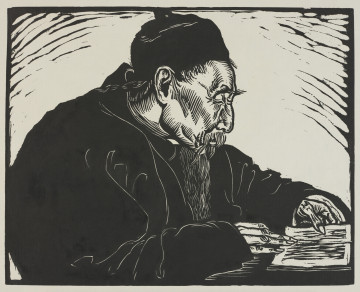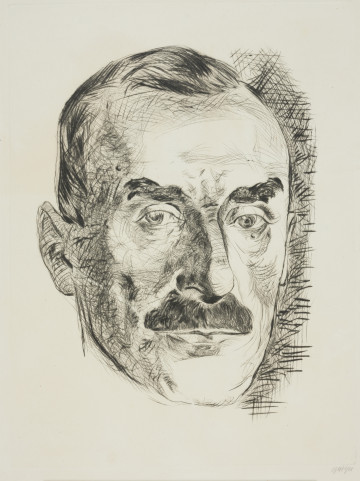
Portrait of Johann Gebhard Rabener
circa 1685 — 1690
National Museum in Szczecin
Part of the collection: Renaissance and Baroque painting
Philip Melanchthon (actually Philipp Schwartzerdt, 1497-1560) was a prominent Protestant theologian and, next to John Bugenhagen (1485-1558), the most important collaborator of Martin Luther (1483-1546). His portrait comes from St Mary's Church in Dąbie, where it was located before the Second World War, together with a second, now lost, image of Martin Luther. Melanchthon is shown in full form, wearing a broad coat with a fur collar, standing under an arcade, and holding a book in his hand. The sails of the arch feature cartouches bearing Melanchthon's emblems. On the left, the serpent writhing on the cross is the serpent of Moses – a symbol he used since 1519. On the right, a crowned lion holding a hammer and pincers is the coat of arms granted by Emperor Maximilian I in 1495 to Melanchthon's father, Georg Schwartzerdt (1459-1508), an armourer at the court in Heidelberg. The inscription above the representation can be translated as follows: A true and actual depiction of the reverend fully enlightened and highly scholarly Mr Philip Melanchthon. The painting on display is in fact a print consisting of 13 sheets, of slightly varying dimensions, pasted on canvas which were stretched over three spruce boards joined together and painted with tempera paints. Despite the lack of a signature, the woodcut used as the base of the painting is believed to be the work of the workshop of Lucas Cranach the Younger (1515-1586). A series of such large-format prints depicting the three reformers Jan Hus, Martin Luther and Philip Melanchthon were created in the second half of the 16th century, and were modelled on earlier prints by Cranach the Younger, including a 1561 depiction of Melanchthon. They were intended to disseminate images of the Reformers in churches, as demand was high and series prints were less expensive than portraits commissioned from painters. However, in this case it was decided to add black and white graphics. Justyna Bądkowska
Author / creator
Object type
painting, graphic
Technique
woodcut, tempera
Material
paper, canvas, spruce wood, tempera
Origin / acquisition method
legal transfer
Creation time / dating
Creation / finding place
Owner
Muzeum Narodowe w Szczecinie
Identification number
Location / status

circa 1685 — 1690
National Museum in Szczecin

1922
National Museum in Szczecin

1926 — 1927
National Museum in Szczecin
DISCOVER this TOPIC
Museum of King Jan III's Palace at Wilanów
DISCOVER this PATH
Educational path